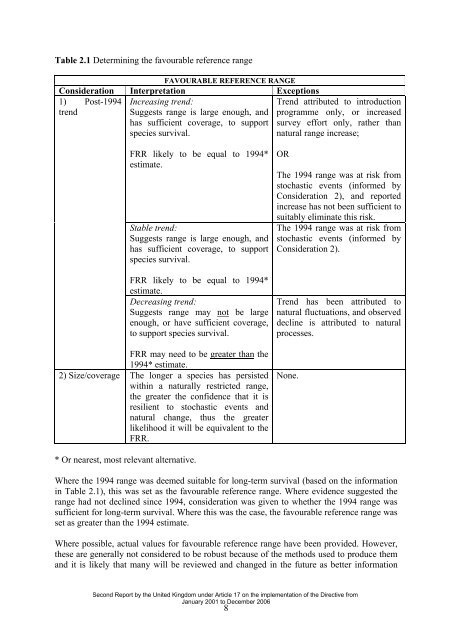Assessing Conservation Status: The UK Approach - JNCC
Assessing Conservation Status: The UK Approach - JNCC
Assessing Conservation Status: The UK Approach - JNCC
You also want an ePaper? Increase the reach of your titles
YUMPU automatically turns print PDFs into web optimized ePapers that Google loves.
Table 2.1 Determining the favourable reference range<br />
FAVOURABLE REFERENCE RANGE<br />
Consideration Interpretation Exceptions<br />
1) Post-1994 Increasing trend:<br />
Trend attributed to introduction<br />
trend<br />
Suggests range is large enough, and programme only, or increased<br />
has sufficient coverage, to support survey effort only, rather than<br />
species survival.<br />
natural range increase;<br />
FRR likely to be equal to 1994*<br />
estimate.<br />
Stable trend:<br />
Suggests range is large enough, and<br />
has sufficient coverage, to support<br />
species survival.<br />
FRR likely to be equal to 1994*<br />
estimate.<br />
Decreasing trend:<br />
Suggests range may not be large<br />
enough, or have sufficient coverage,<br />
to support species survival.<br />
FRR may need to be greater than the<br />
1994* estimate.<br />
2) Size/coverage <strong>The</strong> longer a species has persisted<br />
within a naturally restricted range,<br />
the greater the confidence that it is<br />
resilient to stochastic events and<br />
natural change, thus the greater<br />
likelihood it will be equivalent to the<br />
FRR.<br />
OR<br />
<strong>The</strong> 1994 range was at risk from<br />
stochastic events (informed by<br />
Consideration 2), and reported<br />
increase has not been sufficient to<br />
suitably eliminate this risk.<br />
<strong>The</strong> 1994 range was at risk from<br />
stochastic events (informed by<br />
Consideration 2).<br />
Trend has been attributed to<br />
natural fluctuations, and observed<br />
decline is attributed to natural<br />
processes.<br />
None.<br />
* Or nearest, most relevant alternative.<br />
Where the 1994 range was deemed suitable for long-term survival (based on the information<br />
in Table 2.1), this was set as the favourable reference range. Where evidence suggested the<br />
range had not declined since 1994, consideration was given to whether the 1994 range was<br />
sufficient for long-term survival. Where this was the case, the favourable reference range was<br />
set as greater than the 1994 estimate.<br />
Where possible, actual values for favourable reference range have been provided. However,<br />
these are generally not considered to be robust because of the methods used to produce them<br />
and it is likely that many will be reviewed and changed in the future as better information<br />
Second Report by the United Kingdom under Article 17 on the implementation of the Directive from<br />
January 2001 to December 2006<br />
8
















